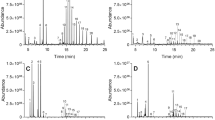Abstract
In assays investigating the abdominal sternal secretion of the cockroach Eurycotis floridana, it was determined that the secretion provides an effective deterrent against potential predators. Analysis of grooming patterns of Peromyscus leucopus mice revealed significant increases in mouth grooming and loss of coordination following exposure to E. floridana secretion. Mouse–cockroach interactions also changed following exposure of the mouse to the spray, as the mouse incited fewer interactions and more frequently struck with its forepaws than with its mouth. Monomorium sp. and Camponotus sp. ants also were repelled by the secretion, and Periplaneta americana were significantly irritated by the application of E. floridana secretion. The secretion is able to deter without physical contact, presumably via noxious volatiles. Eurycotis floridana is capable of accurately aiming the discharge as well as ejecting it several times the length of its body. It also was found that E. floridana exhibits autotoxic responses following contact with the secretion of conspecifics.
Similar content being viewed by others
REFERENCES
Arke, R., Hansen, L.D., and Myhre, E.A. (1995). My house or yours? The biology of carpenter ants. Am. Entomol. 41: 221–226.
Bell, W. J., Gordon, R. E., Toutellot, M. K., and Bred, M. D. (1979). Comparison of male agonistic behavior in five species of cockroach. Insectes Soc. 26: 252–253.
Blum, M. S. (1965). Insect defensive secretions: Hex-2-enal-1 in Pelmatosilpha coriacea (Blattaria) and its repellent value under natural conditions. Ann. Entomol. Soc. Am. 57: 600–602. Efficacy of the Eurycotis floridana Allomone 383
Blum, M. S. (1978). Biochemical defenses of insects. In Rockstein, M. (ed.), Biochemistry of Insects, Academic Press, New York, pp. 466–513.
Blum, M. S. (1981). Chemical Defenses of Arthropods, Academic Press, New York.
Brenner, R. J. (1988). Focality and mobility of some peridomestic cockroaches in Florida. Ann. Entomol. Soc. Am. 81: 581–592.
Brenner, R. J., and Pierce, R. R. (1991). Seasonality of peridomestic cockroaches (Blattoidea: Blattidae): Mobility, winter reduction, and effect of traps and baits. J. Econ. Entomol. 84: 1735–1745.
David-Henriet, A., Farine, J., and Brossut, R. (1995). ‘Les signaux chimiques intervenant dans le comportement sexuel d’ Eurycotis floridana (Dictyoptera, Polyzosteriinae). B. Soc. Entomol. Fr. 100: 109–118.
Dell'Omo, G., and Alleva, E. (1994). Snake odor alters behavior, but not pain sensitivity in mice. Physiol. Behav. 55: 125–128.
Eisner, T. (1961). Demonstration of simple reflex behavior in decapitated cockroaches. Turtox News 39: 196–197.
Eisner, T. (1970). Chemical defense against predation in arthropods. In Sondheimer, E., and Simeone, J. B. (eds.), Chemical Ecology, Academic Press, New York, pp. 157–217.
Eisner, T., and Grant, R. P. (1981).Toxicity, odor aversion, and “olfactory aposematism. ” Science 213: 476.
Eisner, T., McKittrick, F., and Payne, R. (1959). Defense sprays of roaches. Pest Control June: 9–12, 44–45.
Eisner, T., Kriston, I., and Aneshansley, D. J. (1976). Defensive behavior of a termite (Nasutitermes exitiosus). Behav. Ecol. Sociobiol. 1: 83–125.
Farine, J. P., Le Quere, J., Duffy, J., Everaerts, C., and Brossut, R. (1994). Male sex pheromone of cockroach Eurycotis floridana(Walker) (Blattidae,Polyzosteriinae): Role and composition of tergites 2 and 8 secretions. J. Chem. Ecol. 20: 2291–2306.
Farine, J. P., Everaerts, C., Le Quere, J., Semon, E., Henry, R., and Brossut, R. (1997). The defensive secretion of Eurycotis floridana (Dictyoptera, Blattidae, Polyzosteriinae): Chemical identification and evidence of an alarm function. Insect Biochem. Mol. 27: 577–586.
Hebard, M. (1917). Blattidae of North America, North of the Mexican Border. Memoirs of the Annals of the Entomological Society of America, No. 2. American Entomological Society at the Academy of Natural Sciences.
Jefson, M., Meinwald, J., Nowicki, S., Hicks, K., and Eisner, T. (1983). Chemical defense of a rove beetle (Creophilus maxillosus). J. Chem. Ecol. 9: 159–180.
Klotz, J. H., Hansen, L. D., Reid, B. L., and Klotz, S. A. (1999). Carpenter ants. Kans. School Nat. 45: 2–15.
Parmenter, R. R., and MacMahon, J. A. (1988). Factors limiting populations of arid-land darkling beetles (Coleoptera: Tenebrionidae): Predation by rodents. Environ. Entomol. 17: 280–286.
Peschke, K., and Eisner, T. (1987). Defensive secretion of the tenebrionid beetle, Blaps mucronata: Physical and chemical determinats of effectiveness. J. Comp. Physiol. A 161: 377–388.
Petruzzi, S., Fiore, M., Dell'Omo, G., and Alleva, E. (1995). Exposure to ozone inhibits isolationinduced aggressive behavior of adult CD-1 male mice. Aggress. Behav. 21: 387–396.
Rohlf, F. J. (1995). Statistical Tables, 3rd ed.,W. H. Freeman, New York.
Roth, L. M., and Willis, E. R. (1960). The Biotic Associations of Cockroaches. Smithsonian Miscellaneous Collections, 141, Smithsonian Institution, Washington, DC.
Roth, L. M., Niegisch, W.D., and Stahl, W. H. (1956). Occurrence of 2-hexenal in the cockroach Eurycotis floridana. Science 123: 670–671.
Sokal, R. R., and Rohlf, F. J. (1995). Biometry: The Principles and Practice of Statistics in Biological Research, 3rd ed.,W. H. Freeman, New York.
SPSS Inc. (1998). SPSS Base 8.0 Applications Guide, SPSS Inc., Chicago.
Stay, B. (1957). The sternal scent gland of Eurycotis floridana (Blattaria: Blattidae). Ann. Entomol. Soc. Am. 50: 514–519. 384 Turnbull and Fashing
Waterhouse, D. F., and Wallbank, B. E. (1967). 2-Methylene butanal and related compounds in the defensive scent of Platyzosteria cockroaches (Blattidae: Polyzosteriinae). J. Insect Physiol. 13: 1657–1669.
Whitaker, J.O., Jr. (1963). Food of 120Peromyscus leucopus from Ithaca,NewYork. J.Mammal. 44: 418–419.
Wolff, J.O., Dueser, R.D., and Berry, K. S. (1985).Food habits of sympatricPeromyscus leucopus and Peromyscus maniculatus. J. Mammal. 66: 795–798.
Author information
Authors and Affiliations
Corresponding author
Rights and permissions
About this article
Cite this article
Turnbull, M.W., Fashing, N.J. Efficacy of the Ventral Abdominal Secretion of the Cockroach Eurycotis floridana (Blattaria: Blattidae) as a Defense Allomone. Journal of Insect Behavior 15, 369–384 (2002). https://doi.org/10.1023/A:1016217226069
Issue Date:
DOI: https://doi.org/10.1023/A:1016217226069




